rome
 Fog delayed the departure of on September 4, 1963, but the delay was not able to save the plane or its passengers. Swissair Flight 306, a Sud Aviation SE-210 Caravelle III, named Schaffhausen, was scheduled to fly internationally from Zürich to Rome, with a stop in Geneva. Unfortunately, it crashed near Dürrenäsch, Aargau, shortly after take-off, killing all 80 people on board.
Fog delayed the departure of on September 4, 1963, but the delay was not able to save the plane or its passengers. Swissair Flight 306, a Sud Aviation SE-210 Caravelle III, named Schaffhausen, was scheduled to fly internationally from Zürich to Rome, with a stop in Geneva. Unfortunately, it crashed near Dürrenäsch, Aargau, shortly after take-off, killing all 80 people on board.
The plane was due to take off at 06:00 UTC, but the fog was throwing everything off. At 06:04 the flight was allowed to taxi to runway 34 behind an escorting vehicle, to await clearance. Then the crew of Swissair Flight 306, decided to taxi slowly down the runway at 06:05 to inspect the fog. Then they would return to the take off point. Part of the plan was to use high engine power in order to disperse the fog. It must have worked, because around 06:12 the Swissair Flight 306 returned to runway 34 and was allowed to take off. The flight took off at 6:13 and started to climb to flight level 150, which is about 15,000 feet, which would be its cruising altitude.
A short four minutes later, people on the ground witnessed a white trail of smoke coming from the left side of the aircraft. The white streak of smoke gave way to a long flame that erupted from the left wing. Around 06:20 the aircraft reached a height of about 8,900 feet. At that level, the plane began to descend and banking gently to the left before losing altitude more quickly and finally going into a steep and final dive. At 6:21 a frantic mayday message was issued. Then, at 6:22 the Swissair Flight 306 crashed into the ground on the outskirts of Dürrenäsch, approximately 22 miles from Zürich Airport.
So, what brought this plane down just minutes after takeoff. The taxi down the runway in an effort to clear the fog…believe it or not. When the plane went down the runway using full engine power, the pilot also applied the brakes so the plane wouldn’t try to take off. The brakes overheated, causing the magnesium wheels to burst. One of them burst on the runway prior to departure. Then, when the landing gear was retracted, the hydraulic lines in the gear bay were damaged, causing the hydraulic fluid to leak and ignite. The fire damaged the gear bay, and then the wing. Upon looking at the data from the airplane’s flight recorder, it was determined that the crew began experiencing difficulties at 6:18. The data became irregular beginning roughly two minutes later, 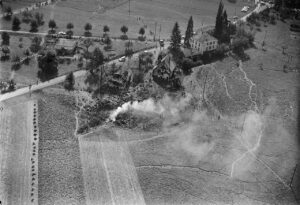 indicating that the fire was causing electrical problems. Analysis of the wreckage indicated that parts of the airplane began detaching “with increasing frequency” at about 6:18. The left engine had shut down prior to the crash, but it is uncertain whether this was from crew action, or a failure caused by the fire. The actual cause for the final loss of control was not conclusively determined, but it seems likely that loss of hydraulics played a key part in it. The rigidity of the left wing and rear fuselage, the integrity of the hydraulic flight control system, and the elevator control unit were all noted as possible areas the fire may have affected in the final portion of the flight to an extent which would have caused a rapid loss of control. In the end, all Caravelles were modified to use non-flammable hydraulic fluids, to avoid a recurrence of this tragedy.
indicating that the fire was causing electrical problems. Analysis of the wreckage indicated that parts of the airplane began detaching “with increasing frequency” at about 6:18. The left engine had shut down prior to the crash, but it is uncertain whether this was from crew action, or a failure caused by the fire. The actual cause for the final loss of control was not conclusively determined, but it seems likely that loss of hydraulics played a key part in it. The rigidity of the left wing and rear fuselage, the integrity of the hydraulic flight control system, and the elevator control unit were all noted as possible areas the fire may have affected in the final portion of the flight to an extent which would have caused a rapid loss of control. In the end, all Caravelles were modified to use non-flammable hydraulic fluids, to avoid a recurrence of this tragedy.
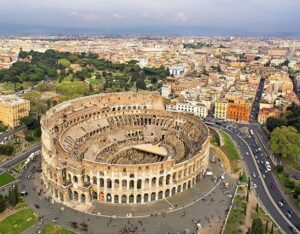
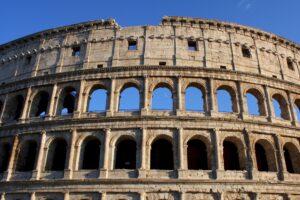 If you visit the Colosseum in Rome these days, you will see a rough-looking shadow of its former glory. The Colosseum was built between 70 AD and 80 AD, under Emperors Vespasian, Titus, and Domitian, the Flavian Emperors. The original name of the Colosseum was the Amphitheatrum Flavium, or the Flavian Amphitheater. Viewed as a populist undertaking by Vespasian, the Colosseum was, at least in part, commissioned as a means to regain the favor of the people, who were restless and unhappy with the imperial institution after Nero’s reign. Planning began in 70 AD and construction in 72 AD. The site of the artificial lake that Nero had constructed as part of the Domus Aurea was chosen for the Colosseum.
If you visit the Colosseum in Rome these days, you will see a rough-looking shadow of its former glory. The Colosseum was built between 70 AD and 80 AD, under Emperors Vespasian, Titus, and Domitian, the Flavian Emperors. The original name of the Colosseum was the Amphitheatrum Flavium, or the Flavian Amphitheater. Viewed as a populist undertaking by Vespasian, the Colosseum was, at least in part, commissioned as a means to regain the favor of the people, who were restless and unhappy with the imperial institution after Nero’s reign. Planning began in 70 AD and construction in 72 AD. The site of the artificial lake that Nero had constructed as part of the Domus Aurea was chosen for the Colosseum.
Most of the labor for the construction of the building was provided by Jewish slaves, who had been taken as prisoners following the first Jewish-Roman war. The Colosseum was constructed of several materials, mainly travertine, limestone, and marble for decorations. They used tuff, volcanic rock, brick, and lime for links. Metals, mainly bronze, were used to bind the stones together. Travertine is a sedimentary limestone, that is found where rivers, springs, lakes used to exist. Beige in color, travertine typically forms in hot springs. The area around Rome is rich with travertine. It forms by the precipitation of calcium carbonate. The travertine that was used to build the Colosseum came from the town of Bagni di Tivoli, formerly Tibur. Travertine is the majority of the stone in the Colosseum, and most of what is left.
The Colosseum’s decorations were in mostly made of marble, but if you go to the Colosseum today, you will not find much of that marble. It has all but disappeared, because it has been reused in the construction of other buildings in Rome. I find that fact to be very strange, since the Colosseum would have been seen as an important center in Rome…or maybe that is just what it is today. The entrances of the cavea and the balustrades were decorated with marble pieces as well. The first 3 rows of seating were also made of marble, a luxury reserved for the most affluent social class. The columns on the outside had marble capitals, and some columns were also in marble.
Of course, metal was needed too. They had to be able to attach the marble to the structure. In the Colosseum, bronze was the primary metal used, but they also used iron. The metal, was heated and stretched into a bar, then curved into a U shape. Adapted to holes intentionally dug into the stones of the facade, these structures served as agraphs to help keep the Colosseum upright. The first fires got the better of these agraphs which were gradually recovered to be melted. Nowadays only the holes in the stones remain, vestiges of this originality in the construction.
The Colosseum was originally clad entirely in marble. When you visit or see the Colosseum these days you’ll notice how the stone exterior appears to be covered in pockmarks all across its surface. Some say that it was not the reusing of the marble in other buildings that brought the Colosseum to it’s current pockmarked state, 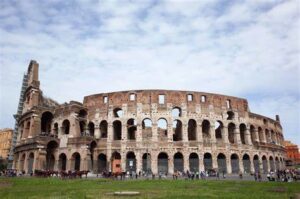
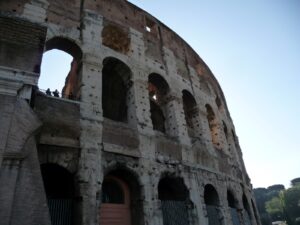 but rather that after the fall of Rome, the city was looted and pillaged by the Goths. They took all of the marble from the Colosseum, and stripped it down to its bare stone setting. Whatever really happened, or even if it was a combination of the two, the Colosseum that stands today looks like a war-torn, broken-down shadow of what it used to be, and yet the fact that it still stands, continues to draw many people from all over the world to visit it every year.
but rather that after the fall of Rome, the city was looted and pillaged by the Goths. They took all of the marble from the Colosseum, and stripped it down to its bare stone setting. Whatever really happened, or even if it was a combination of the two, the Colosseum that stands today looks like a war-torn, broken-down shadow of what it used to be, and yet the fact that it still stands, continues to draw many people from all over the world to visit it every year.
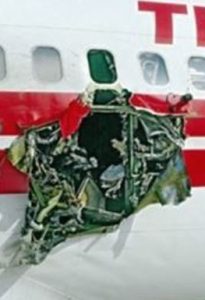 For a time, bombs or bomb threats seemed to be the weapon of choice for terrorists and hijackers on the worlds airlines. With better screenings and luggage checks, things have improved and we see fewer incidences like these, but that in no way means that we should ever let our guard down, because evil exists in this world, and awareness of that fact saves lives. On April 2, 1986, we weren’t quite as prepared as we are today. On that day, Trans World Airlines Flight 840 was on a regularly scheduled flight from Los Angeles to Cairo via New York City, Rome, and Athens. The plane was flying at 11,000 feet over Greece, on its way to Athens, when the bomb went off. Four people, including an eight-month old baby, were sucked out of a TWA passenger jet after an explosion ripped a hole in its side.
For a time, bombs or bomb threats seemed to be the weapon of choice for terrorists and hijackers on the worlds airlines. With better screenings and luggage checks, things have improved and we see fewer incidences like these, but that in no way means that we should ever let our guard down, because evil exists in this world, and awareness of that fact saves lives. On April 2, 1986, we weren’t quite as prepared as we are today. On that day, Trans World Airlines Flight 840 was on a regularly scheduled flight from Los Angeles to Cairo via New York City, Rome, and Athens. The plane was flying at 11,000 feet over Greece, on its way to Athens, when the bomb went off. Four people, including an eight-month old baby, were sucked out of a TWA passenger jet after an explosion ripped a hole in its side.
It blew a hole six feet by three feet wide under a window in front of the starboard wing. It is believed the explosion happened at floor level in the passenger compartment itself. The four bodies of the victims were retrieved from a site 87 miles southwest of Athens. Three were from the same Greek-American family, believed to have been a grandmother, her daughter and her granddaughter. Police also found the body of a male passenger identified as a Colombian-born American, sucked out of the plane still in his seat. Remarkably, the remaining 118 passengers and crew survived, including Christian author, Jeanette Chaffee, who has written about this and other incredible situations, called “Extravagant Graces,” a book I think I will have to read. The pilot, Captain Richard Petersen, made an emergency landing, telling Athens control tower that the pressurization in the cabin was failing.

The pilot, Captain Richard Petersen, made an emergency landing, telling Athens control tower that the pressurization in the cabin was failing. He is being hailed as a hero. “We are proud of him,” said a TWA source. Just seven passengers were taken to hospital, and only three were kept in for treatment. One was Ibrahim al-Nami, from Saudi Arabia, who said he had been sitting next to the man who was sucked out with his seat. “We heard a big bang outside the window,” he said,” and then I saw the man next to me disappear and I felt myself being pulled out.” He avoided sharing the same fate by clinging on to his wife’s seat. Another passenger escaped because she left her seat only minutes earlier to go to the lavatory. Florentia Haniotakis, a Greek-American from Ohio, praised the crew. She says they comforted passengers to calm them during the emergency landing.
The airliner was on the same Rome-Cairo route as a similar TWA plane hijacked by Shia Muslim gunmen in June 1985 after leaving Athens for Rome. The investigation found that the bomb had been planted under seat number 10F, probably inside a lifejacket. A group calling itself the Ezzedine Kassam Unit of the Arab Revolutionary Cells claimed responsibility, and said the bombing was in retaliation for US bombing raids against  Libya the previous month. Police initially suspected a Lebanon-born Palestinian woman named Mai Elias Mansur. Mansur was a suspected terrorist connected with the Abu Nidal extremist group, who was involved in an abortive attempt to bomb a Pan American airliner in 1983. She had travelled in seat 10F on an earlier flight of the same Boeing 727. Mansur denied any involvement. After a two year investigation, the US State Department said it believed that she had carried out the bombing, operating on the orders of known Palestinian terrorist Colonel Hawari, but they were unable to definitively prove it. Therefore, nobody has ever been convicted of carrying out the bombing. TWA filed for bankruptcy in 2001 and was taken over by American Airlines.
Libya the previous month. Police initially suspected a Lebanon-born Palestinian woman named Mai Elias Mansur. Mansur was a suspected terrorist connected with the Abu Nidal extremist group, who was involved in an abortive attempt to bomb a Pan American airliner in 1983. She had travelled in seat 10F on an earlier flight of the same Boeing 727. Mansur denied any involvement. After a two year investigation, the US State Department said it believed that she had carried out the bombing, operating on the orders of known Palestinian terrorist Colonel Hawari, but they were unable to definitively prove it. Therefore, nobody has ever been convicted of carrying out the bombing. TWA filed for bankruptcy in 2001 and was taken over by American Airlines.
 Traditionally, we think of Valentine’s Day as a day of romance and love, but is that really what it is all about? There are several versions of the background surrounding Valentine’s Day, and all of them include St Valentine. The one I find most intriguing involved not love and romance exactly, but rather a time when it was not allowed. St Valentine was a priest who lived around 270 AD in Rome. He found himself at odds with the Roman emperor of the time, Claudius II.
Traditionally, we think of Valentine’s Day as a day of romance and love, but is that really what it is all about? There are several versions of the background surrounding Valentine’s Day, and all of them include St Valentine. The one I find most intriguing involved not love and romance exactly, but rather a time when it was not allowed. St Valentine was a priest who lived around 270 AD in Rome. He found himself at odds with the Roman emperor of the time, Claudius II.
During Saint Valentine’s life time, and under the ruling of Claudius II and other insane administrators, the quality of life in Rome, what had previously been known as the Golden Era, came to an end. There was strife, education declined, taxation increased, and trade declined. This caused a need for more and more soldiers and officers to protect the nation from takeover by the Gauls, Slavs, Huns, Turks and Mongolians from Northern Europe and Asia. In his insanity, Claudius II felt that married men were more emotionally attached to their families, and thus, will not make good soldiers, and he needed many soldiers now. He believed that marriage made the men weak. So he issued an decree forbidding marriage to assure quality soldiers
The people of Rome were afraid of the emperor, and when he made the decision to ban marriage, the people  dared not protest, even though they were shocked. If Claudius II had given any thought to the consequences of his ban, he might have realized how futile it was. If the people did not marry, or at least reproduce, his army would dwindle down to nothing in a matter of years, and if they did at least reproduce, weren’t they still having the same emotional ties as married people? This just goes to show how insane Claudius II was.
dared not protest, even though they were shocked. If Claudius II had given any thought to the consequences of his ban, he might have realized how futile it was. If the people did not marry, or at least reproduce, his army would dwindle down to nothing in a matter of years, and if they did at least reproduce, weren’t they still having the same emotional ties as married people? This just goes to show how insane Claudius II was.
Saint Valentine was a bishop at this time in history, and so began holding secret marriage ceremonies for the soldiers, in complete opposition to Claudius II’s ruling. Saint Valentine was a kindly bishop, and he saw the trauma the unjust decree was causing to young lovers, who had given up all hope of marrying and having children. So, he began secretly performing these marriage ceremonies on the soldiers and their young ladies. Unfortunately, these marriages could not remain hidden for long, and when Claudius II found out about this “friend of lovers”, he was furious. Saint Valentine was arrested and put in prison. Claudius II was impressed with Saint Valentine, when he met him, but when he would not convert to the Roman gods and agree to abide by the marriage ban, Claudius II was angered, and sentenced him to death.
 While awaiting his death sentence, Saint Valentine was approached by his jailor, Asterius whose daughter was blind. Asterius had heard that Saint Valentine was a healer. He asked him to heal his daughter, who was blind. Saint Valentine prayed and the jailor’s daughter was healed. After she was healed, a deep friendship developed between Saint Valentine and the jailor’s daughter, and she was grieved over his imminent death. Right before he was beheaded, Saint Valentine wrote her a farewell message, and signed it “From your Valentine”. It is this note that is said to have begun the traditional Valentine card. Saint Valentine is believe to have been executed on February 14, 270 AD, hence the date for our romantic holiday. In reality it is a day to celebrate the Friend of Lovers. Happy Valentines Day!!
While awaiting his death sentence, Saint Valentine was approached by his jailor, Asterius whose daughter was blind. Asterius had heard that Saint Valentine was a healer. He asked him to heal his daughter, who was blind. Saint Valentine prayed and the jailor’s daughter was healed. After she was healed, a deep friendship developed between Saint Valentine and the jailor’s daughter, and she was grieved over his imminent death. Right before he was beheaded, Saint Valentine wrote her a farewell message, and signed it “From your Valentine”. It is this note that is said to have begun the traditional Valentine card. Saint Valentine is believe to have been executed on February 14, 270 AD, hence the date for our romantic holiday. In reality it is a day to celebrate the Friend of Lovers. Happy Valentines Day!!

